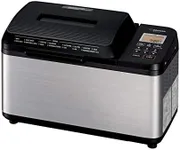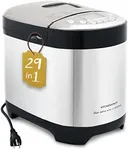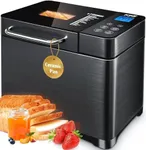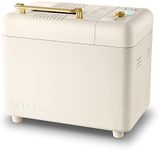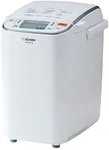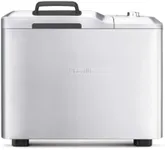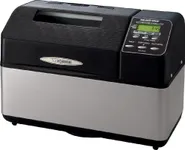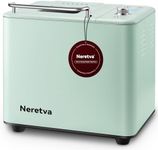Buying Guide for the Best Breadmakers
Choosing the right breadmaker can make a big difference in your baking experience. A breadmaker is a convenient appliance that allows you to bake fresh bread at home with minimal effort. When selecting a breadmaker, it's important to consider various features and specifications to ensure it meets your needs and preferences. Here are some key specs to look out for and how to navigate them.Loaf SizeLoaf size refers to the amount of bread the machine can produce in one baking cycle. This is important because it determines how much bread you can make at once. Breadmakers typically offer loaf sizes ranging from 1 pound to 2.5 pounds. If you have a small household or prefer fresh bread daily, a smaller loaf size (1-1.5 pounds) might be sufficient. For larger families or those who like to bake in bulk, a larger loaf size (2-2.5 pounds) would be more appropriate.
Programs and SettingsPrograms and settings refer to the pre-set options available on the breadmaker for different types of bread and baking processes. This is important because it provides versatility and convenience. Common programs include basic white bread, whole wheat, gluten-free, and dough settings. Some advanced models offer additional settings for cakes, jams, and even yogurt. If you enjoy experimenting with different recipes, look for a breadmaker with a wide range of programs. If you prefer simplicity, a model with basic settings will suffice.
Crust ControlCrust control allows you to choose the desired crust color and texture, such as light, medium, or dark. This is important for achieving the perfect crust to suit your taste. If you like a variety of crust types, look for a breadmaker with adjustable crust control. If you have a specific preference, ensure the breadmaker can consistently produce your desired crust.
Delay TimerA delay timer lets you set the breadmaker to start baking at a later time, so you can wake up or come home to freshly baked bread. This is important for convenience and planning. Delay timers typically range from 13 to 15 hours. If you have a busy schedule and want to enjoy fresh bread at specific times, look for a breadmaker with a delay timer feature. If you plan to bake bread immediately, this feature may not be as crucial.
Kneading PaddlesKneading paddles are the components that mix and knead the dough. This is important for ensuring the dough is properly mixed and has the right texture. Some breadmakers come with a single paddle, while others have dual paddles for more thorough kneading. If you frequently bake dense or whole grain breads, dual paddles may provide better results. For basic bread recipes, a single paddle is usually sufficient.
Viewing WindowA viewing window allows you to monitor the baking process without opening the lid. This is important for checking the progress and ensuring the bread is baking correctly. If you like to keep an eye on your bread as it bakes, look for a breadmaker with a clear viewing window. If you trust the machine to do its job without supervision, this feature may be less important.
Non-Stick PanA non-stick pan ensures that the bread can be easily removed from the breadmaker without sticking. This is important for easy cleanup and maintaining the shape of the loaf. Most modern breadmakers come with a non-stick pan, but it's always good to check. If you want hassle-free bread removal and cleaning, ensure the breadmaker has a high-quality non-stick pan.
